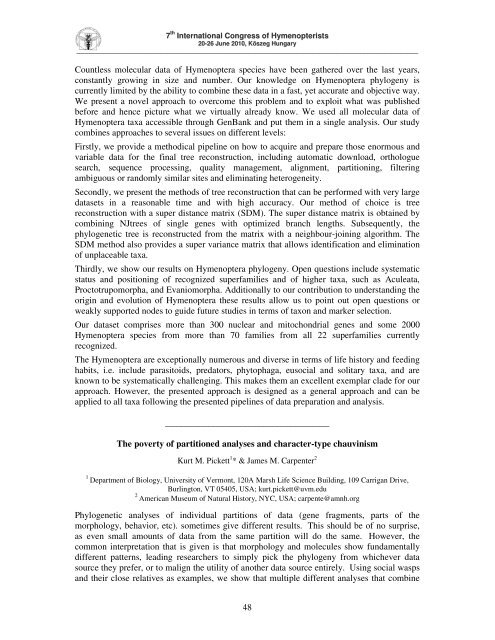Seventh International Congress of Hymenopterists
Seventh International Congress of Hymenopterists
Seventh International Congress of Hymenopterists
You also want an ePaper? Increase the reach of your titles
YUMPU automatically turns print PDFs into web optimized ePapers that Google loves.
7 th <strong>International</strong> <strong>Congress</strong> <strong>of</strong> <strong>Hymenopterists</strong><br />
20-26 June 2010, Kszeg Hungary<br />
_____________________________________________________________________________________________________<br />
Countless molecular data <strong>of</strong> Hymenoptera species have been gathered over the last years,<br />
constantly growing in size and number. Our knowledge on Hymenoptera phylogeny is<br />
currently limited by the ability to combine these data in a fast, yet accurate and objective way.<br />
We present a novel approach to overcome this problem and to exploit what was published<br />
before and hence picture what we virtually already know. We used all molecular data <strong>of</strong><br />
Hymenoptera taxa accessible through GenBank and put them in a single analysis. Our study<br />
combines approaches to several issues on different levels:<br />
Firstly, we provide a methodical pipeline on how to acquire and prepare those enormous and<br />
variable data for the final tree reconstruction, including automatic download, orthologue<br />
search, sequence processing, quality management, alignment, partitioning, filtering<br />
ambiguous or randomly similar sites and eliminating heterogeneity.<br />
Secondly, we present the methods <strong>of</strong> tree reconstruction that can be performed with very large<br />
datasets in a reasonable time and with high accuracy. Our method <strong>of</strong> choice is tree<br />
reconstruction with a super distance matrix (SDM). The super distance matrix is obtained by<br />
combining NJtrees <strong>of</strong> single genes with optimized branch lengths. Subsequently, the<br />
phylogenetic tree is reconstructed from the matrix with a neighbour-joining algorithm. The<br />
SDM method also provides a super variance matrix that allows identification and elimination<br />
<strong>of</strong> unplaceable taxa.<br />
Thirdly, we show our results on Hymenoptera phylogeny. Open questions include systematic<br />
status and positioning <strong>of</strong> recognized superfamilies and <strong>of</strong> higher taxa, such as Aculeata,<br />
Proctotrupomorpha, and Evaniomorpha. Additionally to our contribution to understanding the<br />
origin and evolution <strong>of</strong> Hymenoptera these results allow us to point out open questions or<br />
weakly supported nodes to guide future studies in terms <strong>of</strong> taxon and marker selection.<br />
Our dataset comprises more than 300 nuclear and mitochondrial genes and some 2000<br />
Hymenoptera species from more than 70 families from all 22 superfamilies currently<br />
recognized.<br />
The Hymenoptera are exceptionally numerous and diverse in terms <strong>of</strong> life history and feeding<br />
habits, i.e. include parasitoids, predators, phytophaga, eusocial and solitary taxa, and are<br />
known to be systematically challenging. This makes them an excellent exemplar clade for our<br />
approach. However, the presented approach is designed as a general approach and can be<br />
applied to all taxa following the presented pipelines <strong>of</strong> data preparation and analysis.<br />
____________________________________<br />
The poverty <strong>of</strong> partitioned analyses and character-type chauvinism<br />
Kurt M. Pickett 1 * & James M. Carpenter 2<br />
1 Department <strong>of</strong> Biology, University <strong>of</strong> Vermont, 120A Marsh Life Science Building, 109 Carrigan Drive,<br />
Burlington, VT 05405, USA; kurt.pickett@uvm.edu<br />
2 American Museum <strong>of</strong> Natural History, NYC, USA; carpente@amnh.org<br />
Phylogenetic analyses <strong>of</strong> individual partitions <strong>of</strong> data (gene fragments, parts <strong>of</strong> the<br />
morphology, behavior, etc). sometimes give different results. This should be <strong>of</strong> no surprise,<br />
as even small amounts <strong>of</strong> data from the same partition will do the same. However, the<br />
common interpretation that is given is that morphology and molecules show fundamentally<br />
different patterns, leading researchers to simply pick the phylogeny from whichever data<br />
source they prefer, or to malign the utility <strong>of</strong> another data source entirely. Using social wasps<br />
and their close relatives as examples, we show that multiple different analyses that combine<br />
48


